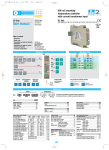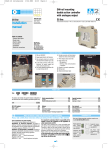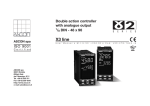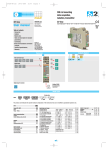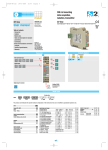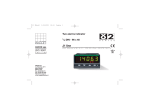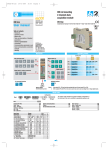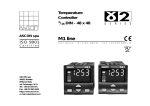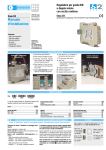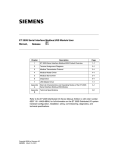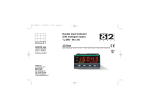Download User manual - Ascon S.p.A.
Transcript
D3ed1 UK - uso 22-04-2003 12:59 Pagina 3 DIN-rail mounting double action controller with analogue output E S E R I E c D3 line ASCON spa D3 line User manual ISO 9 0 0 1 certified User Manual • M.I.U. D3-3/03.04 • Cod. J30-478-1AD3 EF Table of contents - Resources - Model code - Description and table of standard parameters - Description and table of special function parameters - Technical specifications ASCON spa 20021 Bollate (Milan) Italy Tel. +39 02 333 371 Fax +39 02 350 4243 http://www.ascon.it e-mail [email protected] Operating mode Resources Control D3 Retransmission Alarms Main universal input PV/SP PV 12 OP1 1 OP1 OP2 OP3 OP5 OP4 OP1 OP2 OP3 OP5 3 OP5 OP1 OP2 OP3 4 OP1 OP2 OP3 OP5 5 OP1 OP4 OP2 OP3 OP5 6 OP4 OP2 OP1 2 OP2 Digital input (option) IL OP3 OP4 7 Special function Digital input IL function (option) Single action Double action OP1 OP5 OP3 OP5 OP2 OP3 OP5 8 OP5 OP2 OP1 (option) 9 OP5 OP4 OP1 OP2 OP3 10 Setpoint S Modbus RS485 Parameterisation Supervision Valve OP1 OP2 OP3 OP3 OP5 Fuzzy tuning with automatic selection One shot One shot Natural frequency Auto tuning Model code Configuration I L M N - O P Q R Mod. D 3 Line 1st part 2nd part The product code indicates the specific hardware coniguration of Serial communications the instrument, that can be modified by specialized engineers only 5 B C D - E F 0 0 / Basic Accessories D 3 Line B 1 5 Ouput OP1-OP2 Relay - Relay SSR - SSR Input type and range TR Pt100 IEC751 TR Pt100 IEC751 TC L Fe-Const DIN43710 TC J Fe-Cu45% Ni IEC584 TC T Cu-CuNi TC K Cromel-Alumel IEC584 TC S Pt10%Rh-Pt IEC584 TC R Pt13%Rh-Pt IEC584 TC B Pt30%Rh Pt6%Rh IEC584 TC N Nicrosil-Nisil IEC584 TC E Ni10%Cr-CuNi IEC584 TC NI-NiMo18% TC W3%Re-W25%Re TC W5%Re-W26%Re Dc input 0…50mV Dc input 10…50mV Custom input range -99.9…300.0 °C -200…600 °C 0…600 °C 0…600 °C -200 …400 °C 0…1200 °C 0…1600 °C 0…1600 °C 0…1800 °C 0…1200 °C 0…600 °C 0…1100 °C 0…2000 °C 0…2000 °C Engineering units Engineering units C Special function CanBus RS485 Modbus/Jbus SLAVE 3 5 Not fitted Start-up + Timer Options None Valve drive output Analogue output Valve drive output + Analogue output (retr.) D 0 2 5 7 User manual -99.9…572.0 °F -328…1112 °F 32…1112 °F 32…1112 °F -328…752 °F 32…2192 °F 32…2912 °F 32…2912 °F 32…3272 °F 32…2192 °F 32…1112 °F 32…2012 °F 32…3632 °F 32…3632 °F I 0 0 0 0 0 0 0 0 0 0 1 1 1 1 1 1 1 L 0 1 2 3 4 5 6 7 8 9 0 1 2 3 4 5 6 F 0 1 2 3 Italian/English (std) French/English German/English Spanish/English N Alarm 1 type and AL.. function Disabled or used by Timer (only for AL3) Sensor break / LBA active high Absolute active low active high Deviation active low active out Band active in 1 2 3 4 5 6 7 1 2 3 4 5 6 7 0 1 2 3 4 5 6 Setpoint type Local only Local and 2 tracking stored Setpoint Local and 2 Stand-by stored Setpoint R 0 1 2 Control mode ON-OFF reverse action ON-OFF direct action P.I.D. single reverse action P.I.D. single direct action Linear cool output P.I.D. ON-OFF cool output double action Water cool output Oil cool output M 0 1 2 3 4 5 6 7 Output configuration Single Action Double action Relay Heat Relay, Cool Relay SSR drive Heat Relay, Cool SSR Drive Analogue Heat SSR Drive, Cool Relay Heat Relay, Cool Analogue Heat Analogue, Cool Relay Valve drive Heat SSR Drive, Cool Analogue Heat Analogue, Cool SSR Drive 1 E 0 2 O P Q 1 2 3 0 0 0 1 2 3 4 5 6 7 D3ed1 UK - uso 22-04-2003 12:59 Pagina 4 Standard parameters description The parameters shown in the table are divided into groups which work in the same way. Below they will be described as they are listed in the table. Configuration Digital input function - Table 1 Parameter description Not used PV measure hold Auto/Man 1st stored Setpoint 2st stored Setpoint Run Timer IL unit Engineering units - Table 2 Parameter descr. Parameter descr. A (Ampere) °C (degree Centigrade) bar °F (degree Fahrenheit) - ( none) psi Rh mV (millivolt) pH V (Volt) mA (milliampere) Table of standard parameters Configuration Mnemonic code IL Unit Sc.dd Sc.Lo Sc.Hi Prot baud retr rtH Parameter description Digital input function IL Engineering unit N° of decimals Low range High range Communications protocol Baud rate Output range Retransmitted signal Range Units see table 1 see table 2 0...3 -999...9999 engineer. units -999...9999 engineer. units M.bus/Jbus 1200,2400,4800,9600 baud 0...20/4...20 mA PV/SP Factory setting not used none 0 Low range High range M.bus 9600 4-20 PV Notes linear scale only minimum range 100 digit if output OP5 option is present unless used as a control analogue output Setpoint Mnemonic code A1S.P A2S.P A3S.P SL. u SL. d SP L SP H SP 1 SP 2 SP Parameter description AL1 alarm threshold AL2 alarm threshold AL3 alarm threshold Setpoint ramp up Setpoint ramp down Setpoint low range Setpoint high range 1st stored Setpoint 2nd stored Setpoint Setpoint Range PV range PV range PV range OFF / 0.1...999.9 OFF / 0.1...999.9 low range...SP H SP L...high range PV range PV range PV range Units engineer. units engineer. units engineer. units digit/min digit/min engineer. units engineer. units engineer. units engineer. units engineer. units Factory setting Notes It is not enabled if the controller has been 0 configured with alarm n° 2 not active or of 0 sensor break type 0 inhibited With OFF the new Setpoint is reached inhibited immediately after being entered. low range high range ---------- Control mode Setpoint (SP) AL1 - AL2 - AL3 threshold Alarm occurrences of OP1,OP2 and OP3 outputs, respectively linked to A3S.P AL1, AL2 and AL3. The range of the alarm threshold correspond to the whole span and it is not limited by the SP Setpoint span. A1S.P A2S.P SL. u rump up SL. d rump down Setpoint ramp up- Setpoint ramp down This parameter specifies the maximum rate of change of the SP in digit/min. The SP value is reached according to the configured rate of change. The new SP value is called "Target SP" (available via serial communications). Mnemonic code hy. tune P.b. t.i. t.d. O.C. M.res d.err t.c. OP. H S.Out MV.tM MV.hy dbnd r.C.G.a hy. C Example: 350° Target Setpoint 350° Setpoint change 250° SL. u 10 digit/minutes Initial Setpoint 0 t = 10 When the parameter is OFF, this function is disabled and the new Setpoint is reached immediately after being entered. Setpoint low limit and Sepoint high limit Low / high limit of the Setpoint value. t.c. C OP. HC A.Man Parameter description Control output hysteresis Tune run/stop Proportional band Integral time Derivative time Overshoot control Manual reset Error dead band Cycle time Control output high limit Output safety value Motor travel time Minimum output step Dead band Cool relative gain Cool output hysteresis Cool cycle time Cool control output high limit Auto/man selection Units % range Start/stop 0.5...999.9 % range OFF / 0.1...100.0 min OFF / 0.01...10.00 min 0.01...1.00 0.0...100.0 % output OFF / 0.01...10.0 digit sec 1...200 % output 10.0...100.0 % output 0.0...100.0 15...600 sec 0.1...5.0 % output % output -10.0...10.0 0.1...10.0 0.1...10.0 1...200 10.0...100.0 Auto/Man Low limit SP. H High limit SP. L Setpoint range Algorithm Type On - Off Setting 1 is disabled Without integral time PID Time proportional only -100.0...+100.0 Heat/Cool Valve drive On/Off only Time proportional only PID only Heat Cool Range Units % range 0.1...10.0 none / Ltch / Bloc / LtbL OFF / 1...9999 sec OFF / 0.1...100.0 % ouput 1...9999 sec OFF / 1...30 sec OFF / -60...+60 digit 1...247 engineer. units PV range PV range engineer. units Factory setting 0.5 none inhibited 0.5 1 inhibited inhibited 247 ------- Notes The same parameters are available for AL2 and AL3 alarms OFF = sensor break t.mod = OFF only Only if sT.OP different than OFF If OP5 output is present and not configured as control output B - Natural frequncy tune Automatic tune The Fuzzy-Tuning determines automatically the best PID term with respect to the process behaviour. The controller provides 2 types of “one shot” tuning algorithm, that are selected automatically according to the process conditions when the operation is started Setpoint change Tuning start End of the tuning operating and setting of the new calculated terms Control output A - STEP respose SP 1st stored SP - 2nd stored SP Values of the two Setpoints, that are SP. 2 activated by mean of digital input or communications parameters. If configured with “Tracking”, the previous Local Setpoint value will be lost, when the stored Setpoint is selected. If configured with “Stand-by” the Local Setpoint value will not be lost, when the Stand-by Setpoint is selected. It will operate again when back to Local. 0.5 20 100.0 Auto Notes Alarm and auxiliary Mnemonic Parameter description code AL1 hysteresis A1hy Latch.and blocking alarm functions A1Lb LBA delay t.Lba Soft-start output value St.OP Soft-start activation time St.tn Filter time costant t.Fil Input shift In.Sh Communications address Addr Retransmission low range rt.lo Retransmission high range rt.hi Setpoint change SP. 1 5.0 5.0 1.00 1.00 5.0 inhibited 20 100.0 0 60 0.5 0.5 1 % range sec % ouput Control mode Instrument range Factory setting 0.5 Range 0.1...10.00 PV variable End of the tuning operating and setting of the new calculated terms Tuning start This type is selected when the PV is close to the SP Setpoint. This method has the advantage of a better accuracy in the term calculation with a reasonable speed calculation. Control output This type is selected when, at the start of the autotune operation, the PV is far from the Setpoint of more than 5% of the span. This method has the big advantage of fast calculation, with a reasonable accuracy in the term calculation. 2 The Fuzzy Tuning determines automatically the best method to use to calculate the PID term, according the process conditions. D3ed1 UK - uso 22-04-2003 12:59 Pagina 5 Standard parameters description - follows Control mode - follows Heat/Cool control p.B. Proportional band This parameter specifies the proportional band coefficient that multiplies the error (SP - PV) t.i. Integral time It’s the integral time value, that specifies the time required by the integral term to generate an output equivalent to the proportional term. When Off the integral term is not included in the control algorithm. By a sole PID control algorithm, the controller handles two different outputs, one of these performs the Heat action, the other one the Cool action. It is possible to overlap the outputs. A - Heat/Cool actions separated d.bnd positive 0...10.0% 100% O.C. Overshooot control This parameter specifies the span of action of the overshoot control. Setting lower values (1.00 —> 0.01) the overshoot generated by a Setpoint change is reduced. The overshoot control doesn’t affect the effectiveness of the PID algorithm. Setting 1, the overshoot control is disabled. 0% OP. H control output OP.HC cool output Control output high limit It specifies the maximum value the control output can be set. Separate parameters for both heat and cool outputs limitation are available. -100% 0% Heat output r.Cga Relative cool gain It permits to adjust the proportional cool action. 100% 50% In.Sh Input shift This value is added to the measured PV input value. Its effect is to shift the whole PV scale of up to ± 60 digits. Addr Controller address The address range is from 1 to 247 and must be unique for each controller on the communications bus to the supervisor. Heat output 0% 0% PID output On Cool output 100% 50% Off 0% PID output d.bnd Alarm occurances of OP1 - OP2 - OP3 outputs, respectively linked to AL1 - AL2 - AL3 The relay/SSR output OP1, OP2 and OP3, can be used as alarm outputs only if they are not used as control outputs. For each alarm is possible to configure: A - The type and the operationg condition of the alarm B - The functionality of the alarm acknowledgement C - The blocking function on start-up D - Loop break or sensor break A- Alarm type and function Band alarm Deviation alarm Absolute alarm On Off Active low hy high range low range On Active Off high SP On Off Active low SP On Active Off out On Off hy - low range + high range alarm threshold low range Active in hy hy alarm threshold high range B/C- Latching and blocking enable AL1, AL2, AL3 latching and blocking For each alarm it is posA3L.b sible to select the following functions: A1L.b A2L.b None latching blocking both latching and blocking Auxiliary hy. C 100% Cool output alarm threshold d.bnd Dead band It is the zone where it is possible to separate or overlap the heat and cool actions. 0% PID output 50% d.bnd On Active Off high MV.hy Minimum step It specifies the minimum allowed time of activation of the output to a valve that produces a sensible effect. It is related to the deadband of the valve 100% OP. HC OP. H Output safety value Output Value in case of input anomaly. Travel time It provides the time required to the valve to go from the 0% position to 100% Cool output D - On-Off Cool action 100% S.Out MV.tM Heat output 0% 0% PID output 50% B - Heat/Cool actions overlapped d.bnd negative -10.0....0% d.err Error Dead Band Inside this band for (PV - SP), the control output does not change to protect the actuator (output Stand-by) t.c. C cool output d.bnd Cool output 100% Manual reset This specifies the control output value when PV = SP, in a PD only algorithm (lack of the integral term). Control output cycle time It’s the cycle time of the time proportioning control output. The PID control output is provided by the pulse width modulation of the waveform. 100% d.bnd Heat output M.res t.c. control output =2.0 r.Cga 0.1…10.0 =1.0 -100% =0.5 -100% OP. HC OP. H t.d. Derivative time It is the time required by the proportional term P to repeat the output provided by the derivative term D. When Off the derivative term is not included in the control algorithm. C - Cool action adjusting Example with different relative cool gains Alarm acknowledge function The alarm, once occurred, is maintained until to the time of acknowledgement. The acknowledge operation is performed by serial communications. After this operation, the alarm leaves the alarm state only when the alarm condition is no longer present. Start-up disabling Ramp down Disable ∆SP SP On Off Start-up Ramp up SP ∆SP Disable On Off D- “Loop Break Alarm” LBA or sensor break Setting a value between 1 and 9999 sec t.Lba LBA delay the alarm works as LBA+Sensor Setting “none” the alarm works as Sensor break with break with delay. immediate action. Start-up ∆SP Threshold = SP±range When the cause of the alarm disappears, the alarm status stops. Soft-start control output function OP5 Retransmission output (if option installed) When OP5 output is present and not configured as control output, it retransmits linearised PV or SP. With rt.Lo greater than rt.Hi it is possible to obtain a reverse scale. 20 mA St.OP Soft-Start value Value of the control output during the Soft-start activation time. retr = 4-20 rtH = P.V. rt.Lo = 800 rt.Hi = 1200 4 Soft-Start activation time Time duration (starting from the power on) of the Soft-start function. 100% 63,2% °C 0 Soft-start 0% St.tM Power-on 3 PV St.OP St.TM 800 1200 1600 Input digital filter 100% OP Time t.Fil Time Time constant, in sec, of the RC input filter applied to the PV input. When this parameter is set to “inhibited” the filter is bypassed. D3ed1 UK - uso 22-04-2003 12:59 Pagina 6 Special parameters description Table of special function parameters - (if option installed) In order to have the above functions the product code digit emust be 2 For example: mod. D3 3100-2000 To improve the instrument performances and to reduce the wiring and installation costs, two special functions are available: - Start-up - Timer A This functions is disable with Heat/Cool control. Selecting Timer or Start-up, the Soft-start function is disabled, therefore the parameters St.TM St.OP will not be enabled . 1 To select these two functions to use set the parameter as in table 1: Timer/Start-Up operating mode This parameter defines (see table 3): t.Mod - When the count starts. - The state of the control output at the end of the count 2 To select the Start-up function select 1 3 To select the Timer function select the value from 2 to 6 and use alarm AL3 (output OP3) configured with configuration code q= 0. Example: conf. i l m n-o p 0 r Timer and Start-Up Mnemonic code t.Mod t.Act time S.P.Sb t.h.SU S.P.SU Unit see table 3 see table 4 sec/min 1...9999 SP L...SP H 0...500 min SP L...SP H Timer action Timer setting Standy-By Setpoint Start-Up hold time Start-Up Setpoint 5.0...100.0 Control output high limit OP.HS Factory setting 0 0 0.5 0 1 0 Parameter description Range Timer/Start-up operation mode The Start-up function includes three phases: 1a “Limy” - The control output is limited to the OP.HS to 1 Setting t.Mod Three parameters are associated to the Start-up function: 2a “Hold” - The process variable is maintained to the Start-up Setpoint for the time fixed by the parameter t.h.S.U t.h.S.U Start-Up hold time S.P.S.U Start-Up Setpoint OP.HS Control output high limit 3rd “Off” - When the t.h.S.U time is elapsed the process variable is maintained to the working Setpoint. noise power-on th.SU Output to 0 0 Setpoint SP Output to 0 6 When launched stand-by Setpoint Output to 0 7 th.SU 1 digit SP.SU 40 digit OP= OP.HS 1 When launched Control disabled For t.Mod = 7 100.0 output % PV 2 3 4 5 tMode ≠ to 1 Start-Up function Table 3 Timer/Start-up counting mode Disabled Start-up function Counting start time End mode Control mode When inside the band Output to 0 Control mode When lauched Output to 0 Notes with TC = 25% 1sec min. a 1 “Limy” 2a “Hold” 3a “Off” 1a “Limy” 2a “Hold” 3a “Off” SP.SU power-on noise 1 digit PV Setpoint SP 40 digit OP= OP.HS There are two possibilities: A - Start-Up Setpoint SP.SU lower thant the local Setpoint The “Hold” phase starts when the process variable PV achieves the SP.SU (with a tolerance of 1 digit). B - Start-Up Setpoint SP.SU ≥ greater or equal to the local Setpoint When the process variable PV achieves the local Setpoint (with a tolerance of 1 digit), the Start-up function passes directly to the “Off” phase. with TC = 25% 1sec min. If, at the controller power-on, the process variable PV is greater than the lowest between the Whether the process variable, for any reason (e.g. load change), decreases at a SP.SU and the working OP.HS value lower than ( - 40 digits), the Start-up function starts again from Setpoint , the next phase (“Hold” the “Limy” phase. or “Off”) will be executed instead When the Start-up is in Hold phase, if the local Setpoint becomes lower than of the “Limy” phase. the Start-up Setpoint or if the operating mode changes to manual, the Startup function passes to the “Off” phase. a 3a “Off” 1 “Limy” 4 If Timer function is selected it will show the parameter above: t.Act Timer action By this parameter can be defined:(see table 4) - the time units - the starting mode - the OP3 status when the timer is running. When the timer is not running, the OP3 takes the opposite status 1a “Limy” 3a “Off” Timer setting time S.P.SB (only for Timer counting modes Timer (1…9999 sec/min.) Stand-by Setpoint t.Mod = 7)( SP L … SP H ) Table 4 Time units Seconds Minutes Starting mode Manual by serial communications Automatic at the power on [2] Manual by serial communications Automatic at the power on [2] A - Counting start time inside the band, end in control mode. B - Counting start time inside the band, end with control output forced to zero. The time counting starts only when the error is inside a ± 1 digit band. The control action is not affected by the Timer function. The time counting starts only when the error is inside a ± 1 digit band. At the end, the control output is forced to zero. [1] Timer launch OP3 status [1] Value Off On Off On Off On Off On 0 1 2 3 4 5 6 7 time t.Mod =2 Timer launch time t.Mod =3 Setpoint Setpoint ±1 digit band Process variable PV Process variable PV ±1 digit band Output OP Output OP AL3 AL3 [1] If used by Timer [1] When the Timer is not running the control output is forced to zero, also before the Timer launch. [2] Using this selection, manual starting mode is possible too 4 D3ed1 UK - uso 22-04-2003 12:59 Pagina 1 Technical specifications Special function parameters description Timer function mode Features (at 25°C T. envir. temp) C - Counting start time = timer launch time, end in control mode. The time counting starts when the timer is launched. The control action is not affected by the Timer function. By means of the confiurguration tools is possible to choose: Total - the type of input - the type and functionality of the alarms configurability - the type of control input - the type of Setpoint - the type of output - control parameter values time A/D converter with resolution of 50.000 points; Update measurement time: 0.2 sec; Sampling time: 0.5 sec; Input bias: - 60…+ 60 digit; input filter: 1…30 sec. OFF = 0 Common characteristics =4 t.Mod Timer launch Description Setpoint 0,25% ± 1 digit (per termoelementi) 0,1% ± 1 digit (per mA e mV) 2 or 3 wires Resistance Pt100Ω a 0°C connection thermometer (IEC 751) Burnout (for ∆T: R1+R2 °C/°F selectable (with any combination) must be < 320 Ω) Accuracy Process variable PV Output OP PV Input L,J,T,K,S, R, B, N, E,W3,W5 (IEC 584) Rj >10MΩ °C/°F selectable Thermocouple AL3 D - Counting start time = timer launch time, end with control output forced to zero. 4…20mA,0-20mA DC input (current) with external shunt 2.5Ω Rj >10MΩ The time counting starts when the timer is launched. At the end, the control output is forced to zero. [1] 0-50mV DC input (voltage) 10…50mV, Rj >10MΩ The closure of the external contact produces any of the following actions Timer launch time =5 t.Mod Digital input Mode of operation Process variable PV Output OP AL3 Control mode The time counting starts when the timer is launched and the control output is forced to zero. At the end, the control action starts. Burnout. Engineering units Conf. decimal point position Input drift: Init. Scale -999…9999 <0.1% / 20°C Env. Temp. Full Scale -999…9999 <5µV / 10Ω Wire Res. (min. range of 100 digits) Auto/Man mode change, Stored Setpoints activation, measure hold . Timer activation (if options installed) PID with overshoot control or On-off - PID with valve drive algorithm, for controlling motorised positioners Proportional band (P) 0.5...999.9% Integral time (I) 01...100.0 min Derivative time (D) 0.01...10.00 min Error dead band 0.1...10.0 digit Overshoot control 0.01...1.0 Manual reset 0.0...100.0% OFF = 0 Single action PID algorithm Control output high limit 10.0...100% Soft-start output value 0.1...100.0% Output safety value 0.0...100.0% (-100.0...100.0% for Heat / Cool) OFF = 0 On-Off algorithm Control output hysteresis 0.1...10.0% Dead band -10.0...10.0% Relative cool gain 0.1...10.0 Double action PID algorithm (Heat / Cool) with overlap Cycle time (Time proportional only) 1...200 sec Timer launch time =6 t.Mod Line: 150Ω max Input drift: <2µV/°C.Env. Temp <5µV / 10Ω Wire Res. Cycle time (Time proportional only) 1...200 sec [1] When the Timer is not running the control output is forced to zero, also before the Timer launch. E - No control action during the counting time. Max. wire Res: 20Ω max (3 wires) Sensitivity: 0.35°C/10° E. T. <0.35°C / 10Ω Wire Res. 1 single or double action P.I.D. loop or ON/OFF with 1, 2 or 3 alarms Algorithm Setpoint Internal cold junction compensation con NTC Error 1°C/20°C ±0.5°C Burnout Between 100…240V~ the error is minumal Setpoint Process variable PV Control output high limit 10.0...100.0% Cool output hysteresis 0.1...10.0% Motor travel time 15...600 sec Motor minimum step da 0.1...5.0% Valve drive PID algorithm without feedback potentiometer Output OP Digital input commands F - Control action with stand-by Setpoint during the counting time The time counting starts when the timer is launched and the control action use the Stand-by Setpoint. At the end, the control action use the working Setpoint. Timer launch =7 t.Mod time Performed operation Off Function None — — PV measure hold Normal operation PV is hold Set manual mode Automatic Manual 1st stored Setpoint Local 1st SP 2nd stored Setpoint Local 2nd SP — Timer start Standard Setpoint AL3 On Notes Not used The value of PV is “frozen” at the time the digital input goes to the close state The permanent closure forces the chosen stored value. Setpoint modification is not possible. The impulsive closure, selects the stored value. Setpoint modification is allowed. Setpoint Process variable PV Timer S.P. 2 Output OP AL3 The impulsive closure is enough to start the Timer A function is assigned, through the configuration procedure to digital input. The configured function is activated when the digital input (free voltage contact or open collector output) is in the On state (closed). It is deactivated by setting the input to the Off state (open). The activation of the function through the digital input has the highest priority than through the keypad or through the serial communications. 5 D3ed1 UK - uso 22-04-2003 12:59 Pagina 2 Technical specifications Commands Auto/Manual Features Description (at 25°C T. envir. temp) OP1-OP2 SPST Relay N.O., 2A/250V~ for resistive load outputs SSR, 1A/250V~ for resistive load Too meet the double isolation requirements OP1 and OP2 must have the same load voltage OP3 output SPST Relay N.O. 2A/150V~ for resistive load OP4 output The bumpless action is present switching between AUTO, MAN and vice versa with the parameter A.Man . Logic not isolated: 0/5V-, ±10% 30 mA max OP5 output (opt.) Control or PV/SP retr.; Galvanic isolation: 500 V~/1 min; Res. 12bit (0.025%); Accuracy 0.1%; 4/20 mA 750 Ω 15 V max Hysteresys 0.1...10.% Active high Action type AL1 - AL2 AL3 Alarms Active low Action AUTO 100% Setpoint SP SP (PV) ± range Band threshold 0...range Absolute threshold whole range SP Op.r PV 0 100%output OP Deviation threshold AUTO MAN SP = PV OPMAN=OPAUTO OP setting Y OP OP OPAUTO=OPMAN 0 Sensor break, Heater break and Loop break detection Special functions A In case of power failure, the AUTO/MAN status Acknowledge (latching), activation inhibit (blocking) and the output value remain stored in the controller memory Connected to Timer or program (if options installed) Up and down ramps 0.1…999.9 digit/min. (OFF=0) Low limit: from low range to high limit Local plus 2 stored with tracking or Stand-by High limit: from low limit to high range Local Setpoint Timer starting Automatic start at the power on, Digital inputs or serial comm.s Setting time: 1…9999 sec/min Stand-by Setpoint: SC.LO <= SP >= SL.HI Timer Special functions (option) Start-up Setpoint: Hold time : Control output high limit: Start-up SC.LO <= SP >= SL.HI 0...500 min 5.0...100.0% The Timer function can be started or stopped any time. One shot Auto tuning Fuzzy-Tuning one shot The controller selects automatically the best method according to the process conditions Auto/Man station Standard with bumpless function, digital input or serial communications One shot Natural frequency Output lock Serial comm.s RS485 isolated, Modbus/Jbus protocol, 1200, 2400, 4800, 9600 bit/sec, 3 wires Auxiliary +24V– ± 20% 30mA max - for external transmitter supply Supply Detection of out of range, short circuit or sensor break with automatic activation of the Measure input safety strategies and alerts on display Operational Safety Control output Safety value: -100%…100% Parameters Parameter and configuration data are stored in a non volatile memory for an unlimited time Outputs lock t.Act Depending on the Timer action selection, there can be two different starting ways: - Automatic at the power on - Manual by digital inputs or serial communications. Power supply 24V~ (-15% +25%) 50/60Hz e 24V-(dc voltage) (-15% +25%) (PTC protected) The outputs are switched to the OFF via serial communications. A The outputs lock/unlock is maintained in case of power failure. Power consumption 3W max EN61010-1 (IEC1010-1). installation class 2 (2500V), pollution class 2, instrument class II Safety General characteristics Electromagnetic compatibility Protection Dimensions Compliance to the CE standards Terminal strip IP20 Pitch: 22.5 mm - depth: 114.5 mm - with: 53 Serial communications connection example Configuration D3 1 5 2 6 3 7 Configuration Cd-Rom 4 8 RS485 D3 9 10 11 12 13 14 15 16 For SCADA OP30 operator panel PC with Autolink D3 - 31 max instruments D3 - 31 max instruments 1 5 2 6 3 7 4 8 D3 9 10 11 12 13 14 15 16 1 5 2 6 3 7 4 8 D3 9 10 11 12 13 14 15 16 1 5 D3 2 6 3 7 4 8 1 5 2 6 3 7 4 8 D3 9 10 11 12 9 10 11 12 13 14 15 16 13 14 15 16 1 5 2 6 3 7 4 8 D3 9 10 11 12 13 14 15 16 Warranty Local control RS485 1 5 2 6 3 7 4 8 D3 9 10 11 12 13 14 15 16 1 5 2 6 3 7 4 8 D3 9 10 11 12 13 14 15 16 1 5 D3 2 6 3 7 4 8 1 5 2 6 3 7 COM OP30 OPR PAR ALM 1 5 4 8 2 6 3 7 4 8 D3 D3 9 10 11 12 9 10 11 12 13 14 15 16 13 14 15 16 9 10 11 12 13 14 15 16 6 ALM RS485 We warrant that the products will be free from defects in material and workmanship for 3 years from the date of delivery. The warranty above shall not apply for any failure caused by the use of the product not in line with the instructions reported on this manual.






